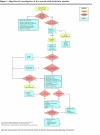Early diagnosis of neonatal cholestatic jaundice: test at 2 weeks
- PMID: 20008595
- PMCID: PMC2793221
Early diagnosis of neonatal cholestatic jaundice: test at 2 weeks
Abstract
Objective: To review best practices for early recognition and treatment of conditions resulting in neonatal cholestasis, in order to improve long-term outcomes for affected infants.
Quality of evidence: Studies, review articles, and meta-analyses pertaining to neonatal-onset cholestasis were sought via electronic databases. Reference lists of studies and review articles supplemented the electronic search. Studies were included if they examined the importance of early diagnosis and intervention for cholestatic jaundice of any cause, and mainly comprised Level II and Level III evidence.
Main message: Review of the relevant literature supports the recommendation that infants with jaundice at 2 weeks of age should be tested for cholestasis by quantifying the direct reacting bilirubin levels in their blood. Subsequent rapid investigation using a diagnostic algorithm enables early diagnosis of the specific cause and facilitates timely intervention for conditions whose outcomes are improved by early treatment.
Conclusion: Universal screening for neonatal cholestasis might help with early identification of cases and improve outcomes, although further study is required in the North American setting.
OBJECTIF: Revoir les meilleures méthodes pour détecter et traiter précocement les conditions résultant de la cholestase néonatale afin d’améliorer les issues à long terme chez les nourrissons affectés.
QUALITÉ DES PREUVES: On a utilisé des bases de données pour répertorier les études, articles de revue et méta-analyses traitant de la cholestase néonatale. On a complété cette recherche électronique par des bibliographies d’études et d’articles de revue. On n’a retenu que les études traitant de l’importance de diagnostiquer et de traiter précocement toutes les formes d’ictère cholestatique et fondées sur des preuves de niveaux II et III.
PRINCIPAL MESSAGE: Cette revue de la littérature pertinente appuie la recommandation voulant qu’on recherche la cholestase chez les nourrissons qui présentent un ictère 2 semaines après la naissance par le dosage des niveaux de bilirubine conjuguée dans le sang. Une brève investigation subséquente à l’aide d’un algorithme de diagnostic permettra alors de préciser rapidement la cause et facilitera l’intervention appropriée dans les cas où une issue favorable dépend d’un traitement précoce.
CONCLUSION: Un dépistage systématique de la cholestase néonatale pourrait aider à détecter précocement les cas et en améliorer les issues; des études additionnelles seront toutefois nécessaires dans le contexte nord-américain.
Figures
Similar articles
-
Clinical practices among healthcare professionals concerning neonatal jaundice and pale stools.Eur J Pediatr. 2017 Mar;176(3):361-369. doi: 10.1007/s00431-016-2847-y. Epub 2017 Jan 12. Eur J Pediatr. 2017. PMID: 28083674
-
Neonatal cholestasis: a red alert for the jaundiced newborn.Can J Gastroenterol. 2000 Nov;14 Suppl D:67D-72D. doi: 10.1155/2000/657368. Can J Gastroenterol. 2000. PMID: 11110615 Review.
-
[Early diagnosis of neonatal cholestatic jaundice].Arch Pediatr. 1998 Sep;5(9):1031-5. doi: 10.1016/S0929-693X(98)80020-1. Arch Pediatr. 1998. PMID: 9789639 French.
-
Clinical practice: neonatal cholestasis.Eur J Pediatr. 2011 Mar;170(3):279-84. doi: 10.1007/s00431-010-1363-8. Epub 2011 Jan 20. Eur J Pediatr. 2011. PMID: 21249394 Review.
-
Neonatal Cholestasis.Pediatr Clin North Am. 2017 Jun;64(3):621-639. doi: 10.1016/j.pcl.2017.01.006. Pediatr Clin North Am. 2017. PMID: 28502442 Review.
Cited by
-
Analysis of factors affecting the prognosis of neonatal cholestasis.Int J Clin Exp Med. 2015 May 15;8(5):8005-9. eCollection 2015. Int J Clin Exp Med. 2015. PMID: 26221362 Free PMC article.
-
A prospective pilot study: can the biliary tree be visualized in children younger than 3 months on Magnetic Resonance Cholangiopancreatography?Pediatr Radiol. 2014 Sep;44(9):1077-84. doi: 10.1007/s00247-014-2953-9. Epub 2014 Apr 8. Pediatr Radiol. 2014. PMID: 24710862
-
Screening for biliary atresia: it's in the cards.Can Fam Physician. 2017 Jun;63(6):424-425. Can Fam Physician. 2017. PMID: 28615387 Free PMC article. No abstract available.
-
Clinical Assessment of Differential Diagnostic Methods in Infants with Cholestasis due to Biliary Atresia or Non-Biliary Atresia.Curr Med Sci. 2018 Feb;38(1):137-143. doi: 10.1007/s11596-018-1857-6. Epub 2018 Mar 15. Curr Med Sci. 2018. PMID: 30074163
-
Clinical practices among healthcare professionals concerning neonatal jaundice and pale stools.Eur J Pediatr. 2017 Mar;176(3):361-369. doi: 10.1007/s00431-016-2847-y. Epub 2017 Jan 12. Eur J Pediatr. 2017. PMID: 28083674
References
-
- Moyer V, Freese DK, Whitington PF, Olson AD, Brewer F, Colletti RB, et al. Guideline for the evaluation of cholestatic jaundice in infants: recommendations of the North American Society for Pediatric Gastroenterology, Hepatology and Nutrition. J Pediatr Gastroenterol Nutr. 2004;39(2):115–28. Erratum in: J Pediatr Gastroenterol Nutr 2004:39(3):306. - PubMed
-
- Trauner M, Meier PJ, Boyer JL. Molecular pathogenesis of cholestasis. N Engl J Med. 1998;339(17):1217–27. - PubMed
-
- Walsh CM, Simpson EA, Zachos M. Gastroenterology and hepatology. In: Dipchand AI, Friedman JN, Bismilla Z, Gupta S, Lam C, editors. The Hospital for Sick Children handbook of pediatrics. 11th ed. Toronto, ON: Elsevier Canada; 2009. pp. 338–9.
Publication types
MeSH terms
LinkOut - more resources
Full Text Sources
Research Materials

